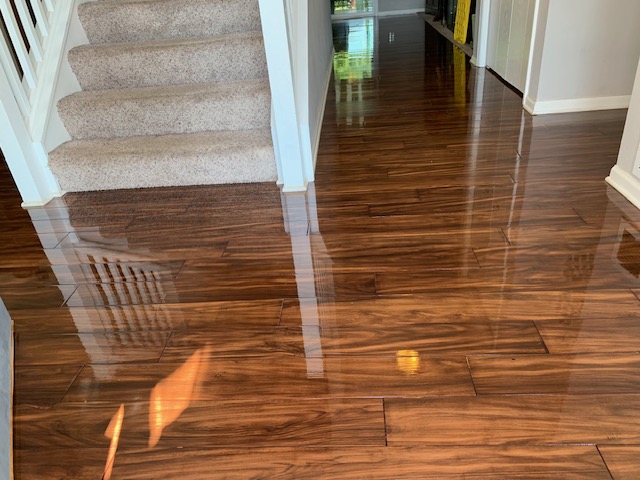How To Remove Scratches From A Hardwood Floor

How to Remove Scratches from Hardwood Floors: A Guide from Choice Hardwoods
Hardwood floors are a beautiful and timeless feature of any home, offering warmth, durability, and natural beauty. However, over time, even the most well-maintained hardwood floors can develop scratches and scuffs. Whether caused by furniture, pet claws, or general foot traffic, scratches can detract from the appearance of your floors, making them look older and worn.
The good news is that many scratches can be easily addressed, and with the right approach, your hardwood floors can look as good as new. At Choice Hardwoods, we’ve seen our fair share of scratched floors, and we’re here to help you understand the best ways to remove them and restore your floors to their former glory.
In this article, we’ll explore various methods to fix scratches on hardwood floors, explain when a screen and coat might be sufficient, and discuss when more invasive repairs are necessary.
Understanding the Different Types of Scratches
Before diving into the different ways to fix scratches, it’s important to understand that not all scratches are created equal. The method you’ll need to use depends on the depth and extent of the scratch. Broadly speaking, scratches can be classified into three categories:
Surface Scratches: These are minor scratches that only affect the top layer of the finish. Surface scratches are often the result of light furniture movement, pet claws, or general wear over time. These are usually not too deep and are typically the easiest to fix.
Shallow Scratches: These scratches penetrate through the finish but do not go deep into the wood. While they may be more noticeable, they generally don’t require extensive repair work.
Deep Scratches: These scratches go beyond the finish and into the wood itself. They can be caused by heavy furniture, dropped objects, or pet claws, and they are the most invasive type of damage. Deep scratches are more difficult to repair, as they often require sanding down the affected area to raw wood and reapplying stain and finish to match the surrounding floor.
Understanding the type of scratch you’re dealing with is the first step in determining the best approach for repair.
1. Fixing Surface Scratches: A Simple Fix
If the scratch is light and only affects the surface finish, it can often be easily fixed with a screen and coat process. This is a non-invasive approach that’s typically used for minor scratches, scuffs, and other superficial signs of wear.
What is a Screen and Coat?
A screen and coat (also known as a buff-and-coat) is a process that involves lightly sanding the existing finish with a screen or abrasive pad to create a smooth surface. This process removes the top layer of the polyurethane finish, allowing a new coat of polyurethane to adhere without the need for full sanding.
The benefits of a screen and coat for minor scratches include:
- Quick and cost-effective: A screen and coat can be completed in a fraction of the time it takes to fully sand and refinish a floor.
- Minimal disruption: Since the process only involves light sanding, it’s relatively low-impact, and your floors can be back to normal in a day or two.
- Restores the shine: The new coat of finish brings back the shine and smoothness of the floor, effectively hiding surface scratches and providing a fresh protective layer.
A screen and coat is perfect for scratches that don’t penetrate too deeply into the finish. It won’t fix deep gouges or damage to the wood, but for general wear and tear, it’s a great solution.
2. Addressing Shallow Scratches: Sanding and Refinishing
For shallow scratches that penetrate through the finish and slightly into the wood, a more invasive approach may be required. While these scratches are more noticeable than surface scratches, they are still not as severe as deep gouges. In this case, spot sanding is a good option.
What is Spot Sanding?
Spot sanding is a more targeted approach where you focus on the area around the scratch, sanding it down to bare wood and reapplying the finish. For shallow scratches, you don’t need to sand the entire floor—just the affected area.
Here’s how the process works:
Identify the damaged area: Start by locating the scratch or scuff and determine its extent. Use a fine-grit sandpaper (usually between 120 and 150 grit) to lightly sand the damaged area.
Smooth the surface: Carefully sand the affected area until the scratch disappears or becomes less noticeable. Take care not to sand too aggressively or extend the sanding beyond the scratch to prevent creating uneven spots.
Stain and Finish: After sanding, you will need to reapply the stain (if the scratch has gone into the wood) to match the rest of the floor. Once the stain has dried, apply a fresh coat of polyurethane to protect the wood and ensure a consistent look with the surrounding floor.
Spot sanding can be a great solution for shallow scratches, as it allows you to address the damage without having to sand down the entire floor. However, if there are several shallow scratches across the floor, it might be more efficient to consider a more comprehensive sanding process.
3. Repairing Deep Scratches: Full Sanding and Refinishing
When scratches are deep enough to penetrate into the wood, they may require full sanding and refinishing to restore the floor. Deep scratches, gouges, and nicks that go beyond the finish and into the wood itself are much harder to repair and may require sanding the affected area down to raw wood.
Why Full Sanding is Necessary for Deep Scratches
Deep scratches often create more noticeable flaws in the floor’s surface. Simply filling the scratch with a wood filler or using a touch-up marker will not fully restore the smooth surface or finish of the floor. Sanding down to raw wood is necessary to address the damage and ensure the scratch is fully removed.
Here’s what the full sanding process typically looks like:
Sanding the Affected Area: The first step is to sand the affected area (or areas) down to raw wood. This can be done using a drum sander for larger areas or an orbital sander for smaller patches. Sanding removes the top layers of wood and any finish, smoothing the surface of the board.
Staining the Wood: After sanding, you’ll need to apply a matching stain to the affected area. This ensures that the newly exposed wood blends in seamlessly with the rest of the floor. Staining helps restore the color and character of the wood, allowing the refinished section to match the rest of the floor.
Applying a New Finish: Once the stain has dried, a fresh coat of polyurethane or other protective finish is applied to the area. This step not only protects the wood but also helps seal in the stain and ensures a uniform shine across the floor.
Blending the Repair: To ensure the repaired area blends perfectly with the surrounding boards, professional refinishing often involves sanding the edges where the new finish meets the existing finish. This smooths out any lines or discrepancies between the old and new finish.
Full sanding and refinishing of deep scratches can be a time-consuming and invasive process, but it’s the only way to completely restore deep damage to your hardwood floor.
4. When the Damage is Extensive: Full Sand and Refinish
In some cases, the damage to your hardwood floors may be so widespread that the best solution is to fully sand and refinish the entire floor. If scratches, gouges, dents, and discoloration are present throughout the floor, a full sanding is the most effective way to restore the floor’s uniformity and beauty.
A full sand and refinish process involves:
Sanding the entire floor: Using professional-grade equipment, the top layers of the wood are sanded down to raw wood. This process removes not only the old finish and scratches but also any other imperfections, such as stains or dents.
Staining and finishing: After sanding, the entire floor is restained and refinished, ensuring that the entire surface matches in color and shine.
While more time-consuming and costly than spot repairs, a full sand and refinish can dramatically improve the appearance of your floors, especially if they’ve experienced widespread damage. It’s often the best option when a floor has been subject to heavy wear and tear or when multiple areas are affected by deep scratches.
Conclusion
Scratches on hardwood floors are a common issue, but fortunately, there are several ways to address them depending on the severity of the damage.
- Surface scratches can often be fixed with a quick and simple screen and coat process, which restores the finish and hides minor imperfections.
- Shallow scratches that penetrate the finish but not the wood can be repaired through spot sanding, followed by staining and refinishing the affected areas.
- Deep scratches that damage the wood require full sanding of the affected boards, followed by restaining and finishing to match the rest of the floor.
In cases where the scratches are widespread and the floor has significant wear, it may be necessary to fully sand and refinish the entire floor to restore its original beauty.
If you’re unsure of the best approach for your floors, our team at Choice Hardwoods is here to help. We can assess the damage, recommend the right repair strategy, and restore your hardwood floors to their full potential. Contact us today to learn more about our refinishing services and get a free estimate!

